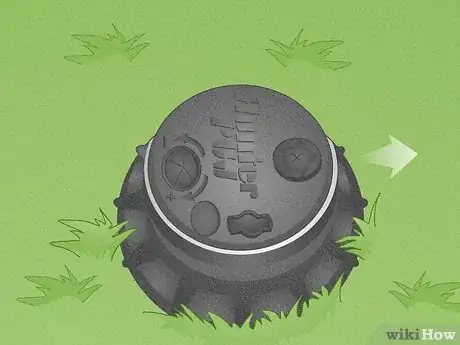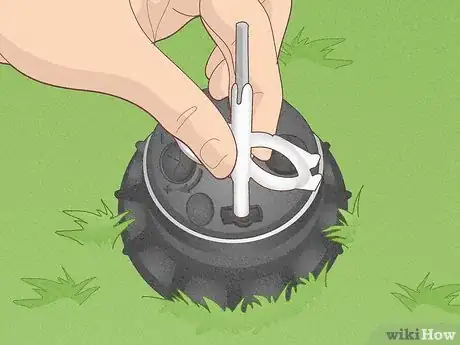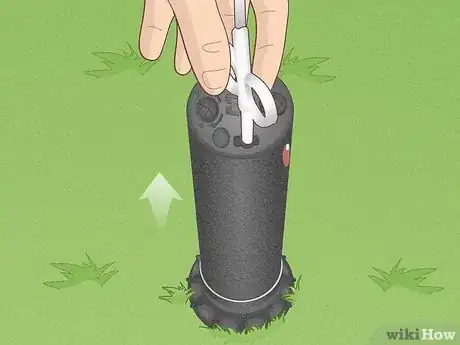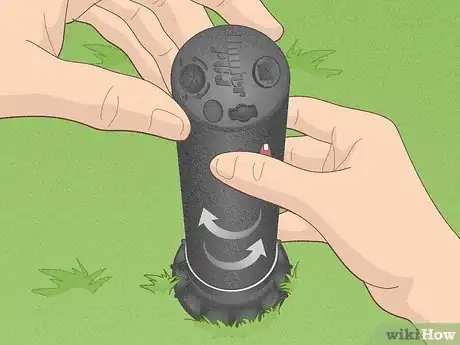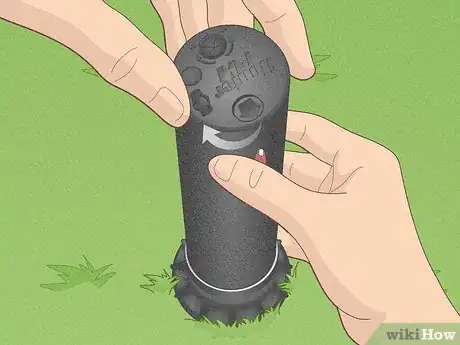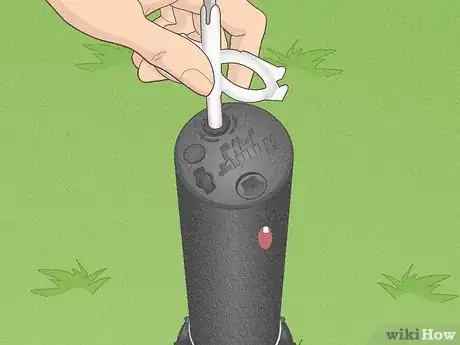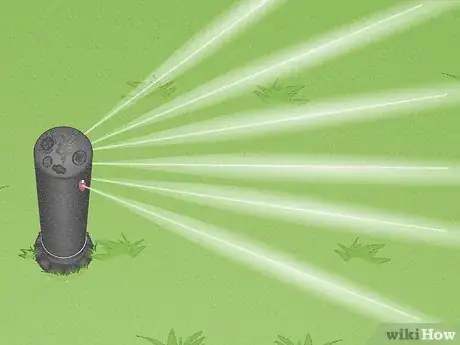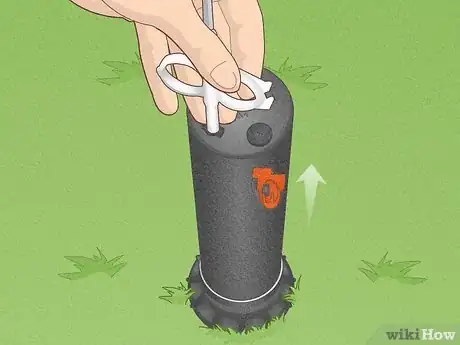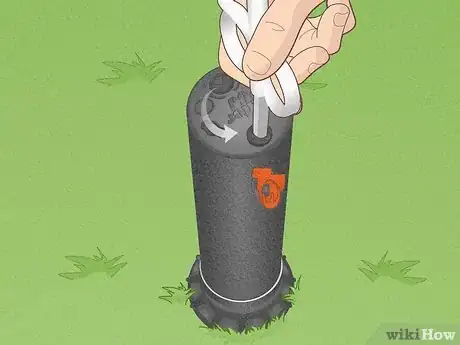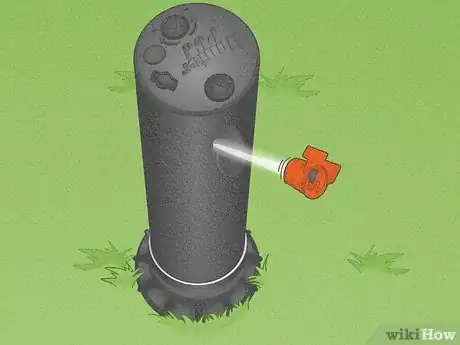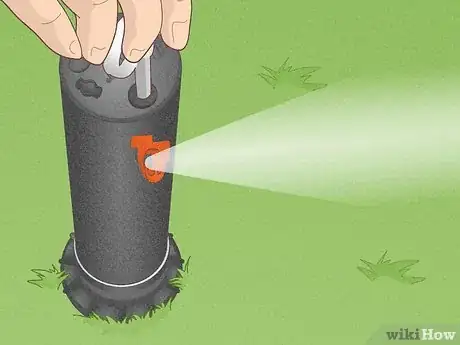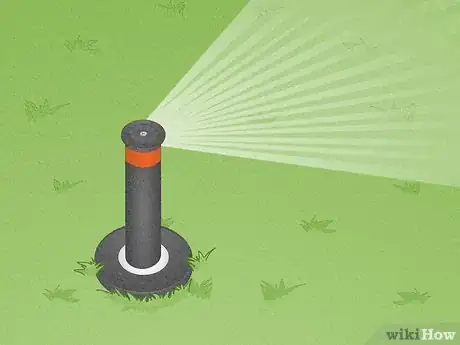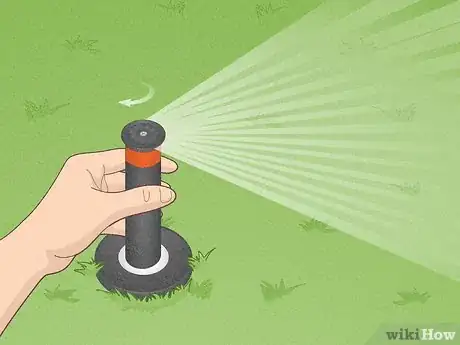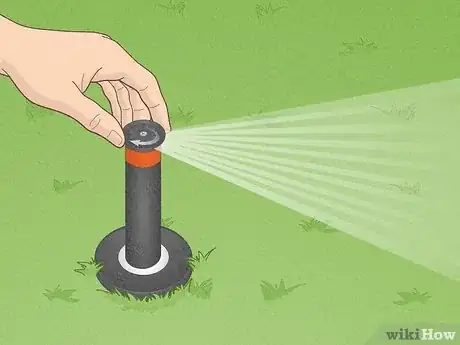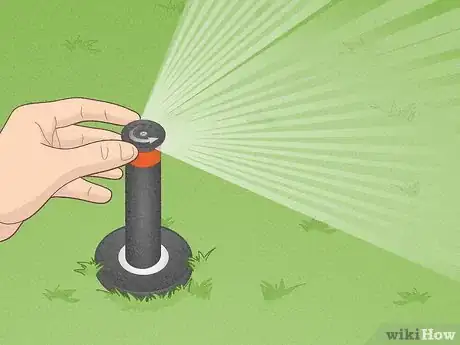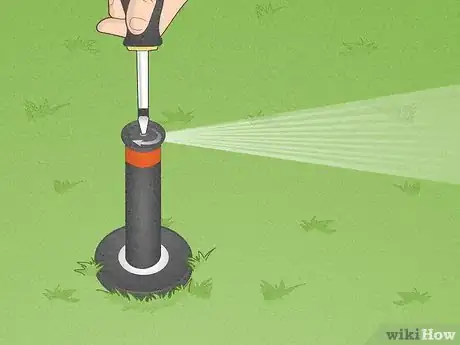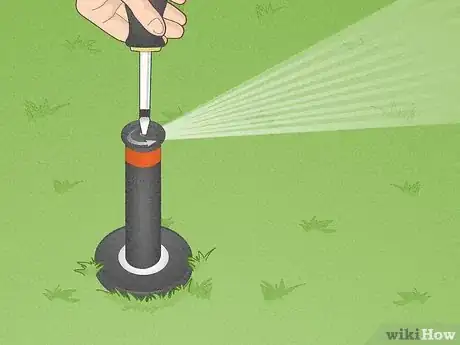This article was co-authored by Mike Garcia and by wikiHow staff writer, Danielle Blinka, MA, MPA. Mike Garcia is a Licensed Landscape Contractor and the Founder of Enviroscape LA, a full-service landscape design and construction firm in Los Angeles, California. With over 30 years of experience, Mike specializes in sustainable landscape practices. Mike holds an Ornamental Horticulture degree, C-27 Landscape Contractor and D-49 Tree Service Contractor licenses, and Permaculture Design, California Naturalist, International Certified Professional Pond Contractor, and Pond Building certifications. He is one of eight Internationally Certified Pond Builders in the world. Enviroscape LA has won landscape and water feature awards from the International Professional Pond Contractors Association (IPPCA), National Association of Pond Professionals (NAPP), and the California Landscape Contractors Association (CLCA). Mike is a past president of the CLCA and currently serves on their local Board of Directors. Enviroscape LA has been featured in PONDS USA Magazine, Pond and Garden Lifestyles Magazine, and the Los Angeles Times. Mike has appeared on Extreme Home Makeover, HGTV's Landscapers Challenge, and A & E's series Fix That Yard.
There are 14 references cited in this article, which can be found at the bottom of the page.
This article has been viewed 22,628 times.
You can adjust the spray of your sprinklers to keep your lawn happy and healthy. Sprinklers are a convenient way to maintain a lush lawn or irrigate a garden. However, they only work if they effectively water your property! We’re going to walk you through the easiest ways to adjust Hunter sprinklers, from the radius and the arc to the precipitation rate and nozzles.
Steps
Radius Adjustment
The radius is the distance from the sprinkler head to the edge of the water spray. It comes preset to your sprinkler nozzle's maximum distance, and you can reduce it by up to 25%.[1]
-
1Insert the hex end of your Hunter wrench key into the radius reduction screw. The hex end is the slim, square bar that sticks out on one side of your Hunter wrench key. The radius reduction screw is a small hole at the center of the arrow with a tiny “x” in the middle. You'll find it on your sprinkler cap.[2]
- If you’ve lost your Hunter wrench key, no worries! You can actually use a normal 3/32 Allen key to make this adjustment.[3]
- You can make this adjustment with the water on or off.
-
2Turn the hex bar clockwise to decrease the radius. Go slowly and stop when you’re happy with the radius. Alternatively, stop turning when you feel resistance.[4]
- Your hex bar will stop turning when you’ve reduced the radius by 25%. You can’t reduce the radius more than this.
Advertisement -
3Spin the hex bar counterclockwise to increase the radius. If your radius is too small now, simply turn the hex bar back the other way. The radius will expand again up to the full preset radius.[5]
- You may need to adjust the radius back and forth to get your desired sprinkler coverage. If you can’t get the radius you want, switch out your nozzle to a bigger nozzle for a wider radius or a smaller nozzle for a smaller radius.[6] You can find instructions on how to do this in the Precipitation Rate section below.
Rotor Head Adjustment
The rotor head controls the arc, which is the sprinkler coverage from side-to-side. Hunter PGJ adjustable heads can be set anywhere from 40 degrees to 360 degrees, while PGP Ultra heads can be set from 50 degrees to 360 degrees.[7] [8]
-
1Find the arrow on top of the sprinkler cap to locate the nozzle. Look for a raised, rubber circle with the outline of an arrow on it. Follow the arrow to locate where the water sprays out of the sprinkler nozzle.[9]
- You can adjust your sprinkler with the water on or off.
-
2Insert your Hunter wrench key into the pull-up socket. The pull-up socket looks like the planet Saturn. There’s a circle in the middle and a line running through it. Push the key end of your Hunter wrench into this hole.[10]
-
3Twist the key and pull up on the socket. The entire sprinkler head will pop out of the base so you can adjust the inner assembly. Now, you can check your arc distance and change it if necessary.[11]
- You can remove the Hunter wrench while the sprinkler head is pulled up. You’ll actually need it to make adjustments to the left. You can adjust the sprayer toward the right without the key.
-
4Check the current arc by spinning the head to the left, then the right. Use your hand to gently twist the sprinkler head as far to the left as it will go. Note where the arrow is pointing, as this is the left stop of your arc. Next, spin the head back toward the right as far as it will go. Check where the arrow is pointing because this is the right stop.[12]
- Do this first so you know how far you need to adjust the sprinkler arc.
-
5Twist the sprinkler head to the right to line up the arrow with your right stop. Use your hand to gently tighten the sprinkler head. Keep going until the arrow is pointing where you want the sprinkler to stop spraying on the right side of its arc.[13]
- If your base won’t tighten any more, grasp the entire sprinkler cap and turn it clockwise to loosen it. Then, lift the inner assembly out of the sprinkler base. Spin the cap all the way to the right, then put it back in the base with the arrow pointing at your right stop. Twist the cap clockwise to tighten it into the base. Your arrow should be pointing at your right stop.[14]
-
6Insert your Hunter wrench key into the plus/minus arc adjustment slot on the cap. The plus/minus arc adjustment slot has a big “X” on it. Push the key end of your Hunter wrench into this hole to make adjustments.[15]
-
7Hold the sprinkler head while turning the key clockwise to widen the arc. Use your hand to hold the sprinkler head in place so the arrow stays pointing on your right stop. Then, turn the key clockwise to widen the arc. Each full turn will widen the arc by 90 degrees. Stop if you meet resistance or hear a grinding sound.[18]
- The highest you can widen your arc is 360 degrees. When you reach this point, the key will either stop moving or you’ll hear a grinding sound.
- Clockwise is the plus, or positive, direction.
-
8Check the arc to make sure the stop points are correct. Turn your sprinkler head all the way to the right, then all the way to the left. Make sure the arrows line up with your desired right and left stop points.[19]
-
9Turn the key counterclockwise to shorten the sprinkler arc. If you widen your arc too far, don’t worry. Simply turn the Hunter wrench key a little in the counterclockwise direction. This will shorten your arc.[20]
- Counterclockwise is the minus, or negative, direction.
-
10Push down on the sprinkler head to close it. Once your adjustments are complete, you can simply slide your sprinkler head back down into the base. You’re all set to water your plot![21]
Precipitation Rate and Nozzles
The precipitation rate is how much water your sprinkler will spray. To change the precipitation rate, you’ll need to switch your nozzle to a different size.
-
1Insert the key end of your Hunter wrench key into the pull-up socket. The pull-up socket looks like the planet Saturn because it’s a circle with a line through it. Turn the key 90 degrees and lift up the inner assembly. [22]
- You won’t be able to change the nozzle without your Hunter wrench key.
-
2Put the hex bar into the radius reduction screw and turn counterclockwise. The hex bar is the slim, square metal bar on your Hunter wrench key. The radius reduction screw is the hole on the arrow on your sprinkler cap. Twist the bar as far as it will go counterclockwise to uncover the nozzle.[23]
- If the bar doesn’t move, you can go on to the next step.
- The arrow points to where your nozzle is, so the nozzle will be just below the arrow.
-
3Turn on the water to push out the nozzle. Remove the hex bar if you haven’t already. The force of the water will blow out the nozzle, since there’s nothing holding it in. Turn off the water so you can install the new nozzle.[24]
- If you prefer, you can remove the nozzle by hand by grasping the edge of the nozzle with needle-nosed pliers and pulling outward. Remember, the nozzle is just below the arrow on your sprinkler cap.
- Keep the nozzle if it’s not damaged, as you can reuse it later.
-
4Install a larger nozzle if you want higher precipitation. Use a larger nozzle if your soil tends to be dry. Gently push your new nozzle into the hole below the arrow on your sprinkler cap. Reinsert the hex bar so you can tighten the nozzle range screw.[25]
-
5Insert a smaller nozzle for lower precipitation. Go with a smaller nozzle if your soil gets too wet. Slide the new nozzle into the hole under the arrow on your sprinkler cap. Then, tighten the nozzle range screw using the hex bar.[26]
Spray Sprinkler Adjustments
Spray heads produce a constant stream of water, but don’t do any rotation like a rotor head does.
-
1Turn the sprinkler on while you adjust it so you can see the spray. You want the water on so you can see which area of your lawn is getting watered. Observe the direction and arc of the spray so you know what adjustments you need to make.[27]
-
2Use your hand to turn the sprayer to your right stop point. Hold the base of the sprinkler in one hand as you slowly twist the sprayer toward the right. You’ll hear a ratcheting noise with each turn, which is okay. The sprinkler is supposed to make that noise when it turns because its base is a ratchet system. Stop turning the sprinkler when the water is spraying toward your desired right stop point.[28]
- If you go too far, just spin the sprayer back toward the left.
-
3Spin the nozzle clockwise to decrease the arc. The nozzle on a spray sprinkler is the top cap on the sprinkler where the water comes out. Grip the edges of this cap, then twist. The water spray will start to narrow, covering less ground. Stop turning the nozzle when you reach your desired arc.[29]
- You don’t need any special tools to adjust spray sprinklers.
- If you go too far, just twist it back the other way.
-
4Twist the nozzle counterclockwise to increase the arc. Use your hand to grip the edges of the nozzle cap and turn it. Watch the spray expand until the water reaches as far as you'd like. Stop spinning the cap when you’re happy with the arc.[30]
- If the arc gets too wide, simply spin the nozzle back counterclockwise.
-
5Reduce the radius by turning the nozzle screw clockwise. The nozzle screw is at the center of the sprinkler cap where the water sprays out. Insert a 1⁄4 inch (0.64 cm) flat-head screwdriver into the screwhead. Slowly spin the screwdriver to shorten the radius, which is how far the water reaches. Stop twisting when you’re happy with your sprinkler coverage.[31]
-
6Increase the radius by turning the nozzle screw counterclockwise. Find the nozzle screw at the center of the sprinkler cap, which is where the water sprays out. Use your 1⁄4 inch (0.64 cm) screwdriver to slowly turn the screwdriver counterclockwise to widen your radius, which is how far the water sprays. Keep turning until you’re happy with your sprinkler coverage.[32]
References
- ↑ https://www.bwlawnsprinklers.com/pdfs/hunterPGJ_instruct.pdf
- ↑ https://www.bwlawnsprinklers.com/pdfs/hunterPGJ_instruct.pdf
- ↑ https://www.hunterindustries.com/support/residential-rotors-adjustment-instructions
- ↑ https://www.greencaremankato.com/lib/Hunter%20PGP%20Rotary_manual.pdf
- ↑ https://www.greencaremankato.com/lib/Hunter%20PGP%20Rotary_manual.pdf
- ↑ https://www.bwlawnsprinklers.com/pdfs/hunterPGJ_instruct.pdf
- ↑ https://www.bwlawnsprinklers.com/pdfs/hunterPGJ_instruct.pdf
- ↑ https://www.greencaremankato.com/lib/Hunter%20PGP%20Rotary_manual.pdf
- ↑ https://www.youtube.com/watch?v=d4c0IjeyYek&t=28s
- ↑ https://www.greencaremankato.com/lib/Hunter%20PGP%20Rotary_manual.pdf
- ↑ https://www.youtube.com/watch?v=d4c0IjeyYek&t=72s
- ↑ https://www.bwlawnsprinklers.com/pdfs/hunterPGJ_instruct.pdf
- ↑ https://www.youtube.com/watch?v=d4c0IjeyYek&t=111s
- ↑ https://www.youtube.com/watch?v=d4c0IjeyYek&t=195s
- ↑ https://www.bwlawnsprinklers.com/pdfs/hunterPGJ_instruct.pdf
- ↑ https://upgradedhome.com/how-to-adjust-sprinkler-heads-without-a-key/
- ↑ https://www.hunterindustries.com/support/residential-rotors-adjustment-instructions
- ↑ https://www.hunterindustries.com/support/residential-rotors-adjustment-instructions
- ↑ https://www.bwlawnsprinklers.com/pdfs/hunterPGJ_instruct.pdf
- ↑ https://www.youtube.com/watch?v=d4c0IjeyYek&t=146s
- ↑ https://www.youtube.com/watch?v=d4c0IjeyYek&t=157s
- ↑ https://www.greencaremankato.com/lib/Hunter%20PGP%20Rotary_manual.pdf
- ↑ https://www.greencaremankato.com/lib/Hunter%20PGP%20Rotary_manual.pdf
- ↑ https://www.bwlawnsprinklers.com/pdfs/hunterPGJ_instruct.pdf
- ↑ https://www.bwlawnsprinklers.com/pdfs/hunterPGJ_instruct.pdf
- ↑ https://www.bwlawnsprinklers.com/pdfs/hunterPGJ_instruct.pdf
- ↑ https://www.youtube.com/watch?v=hediV4JOfxM&t=67s
- ↑ https://www.youtube.com/watch?v=hediV4JOfxM&t=74s
- ↑ https://www.youtube.com/watch?v=hediV4JOfxM&t=95s
- ↑ https://www.youtube.com/watch?v=hediV4JOfxM&t=95s
- ↑ https://www.youtube.com/watch?v=hediV4JOfxM&t=103s
- ↑ https://www.youtube.com/watch?v=hediV4JOfxM&t=103s



